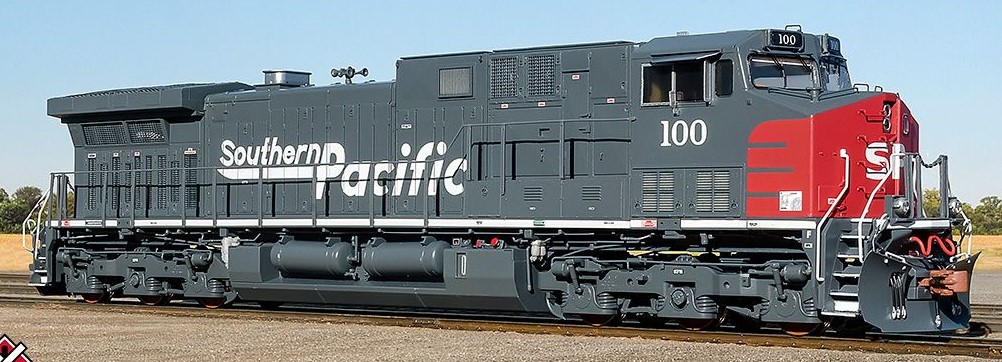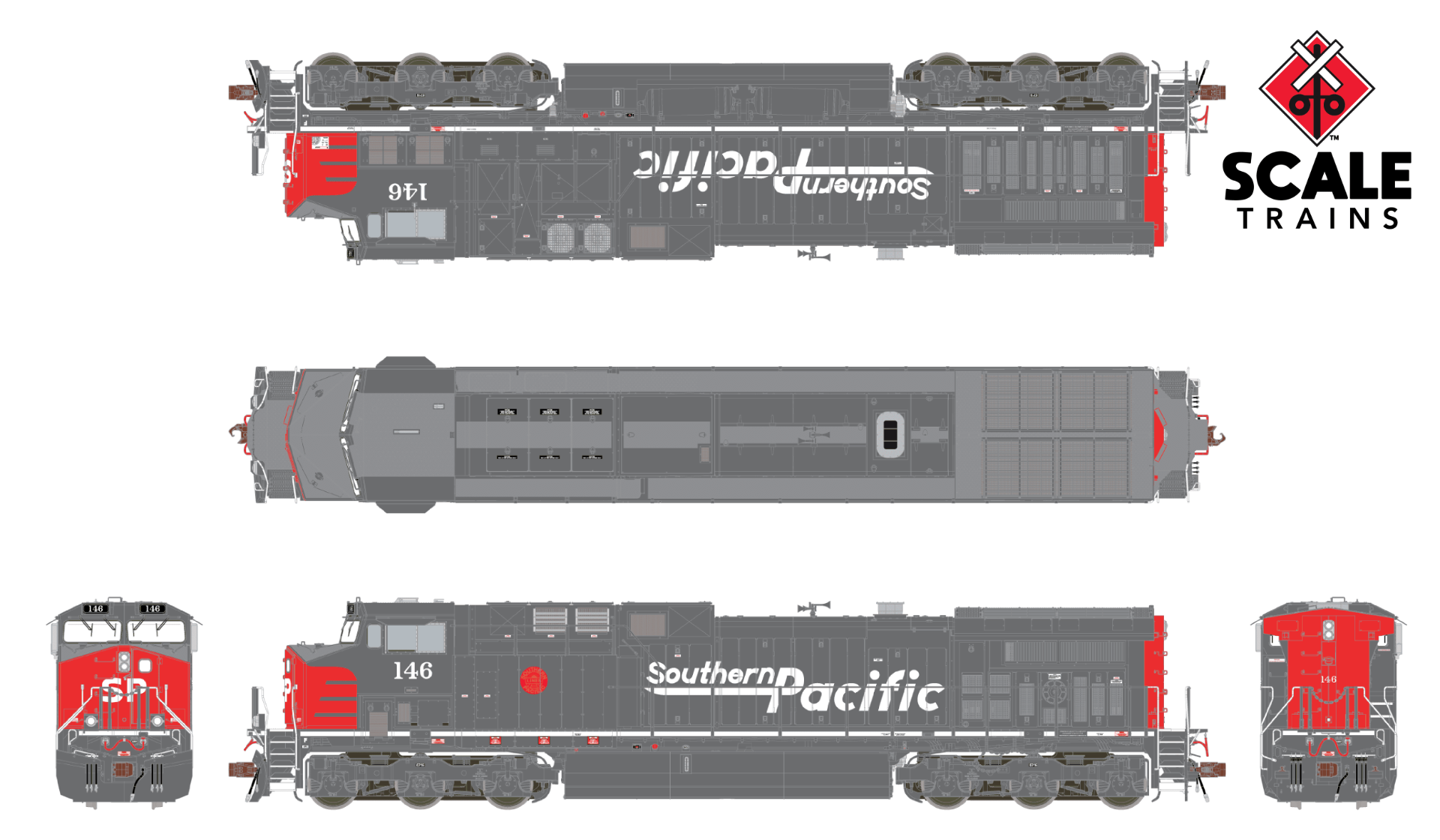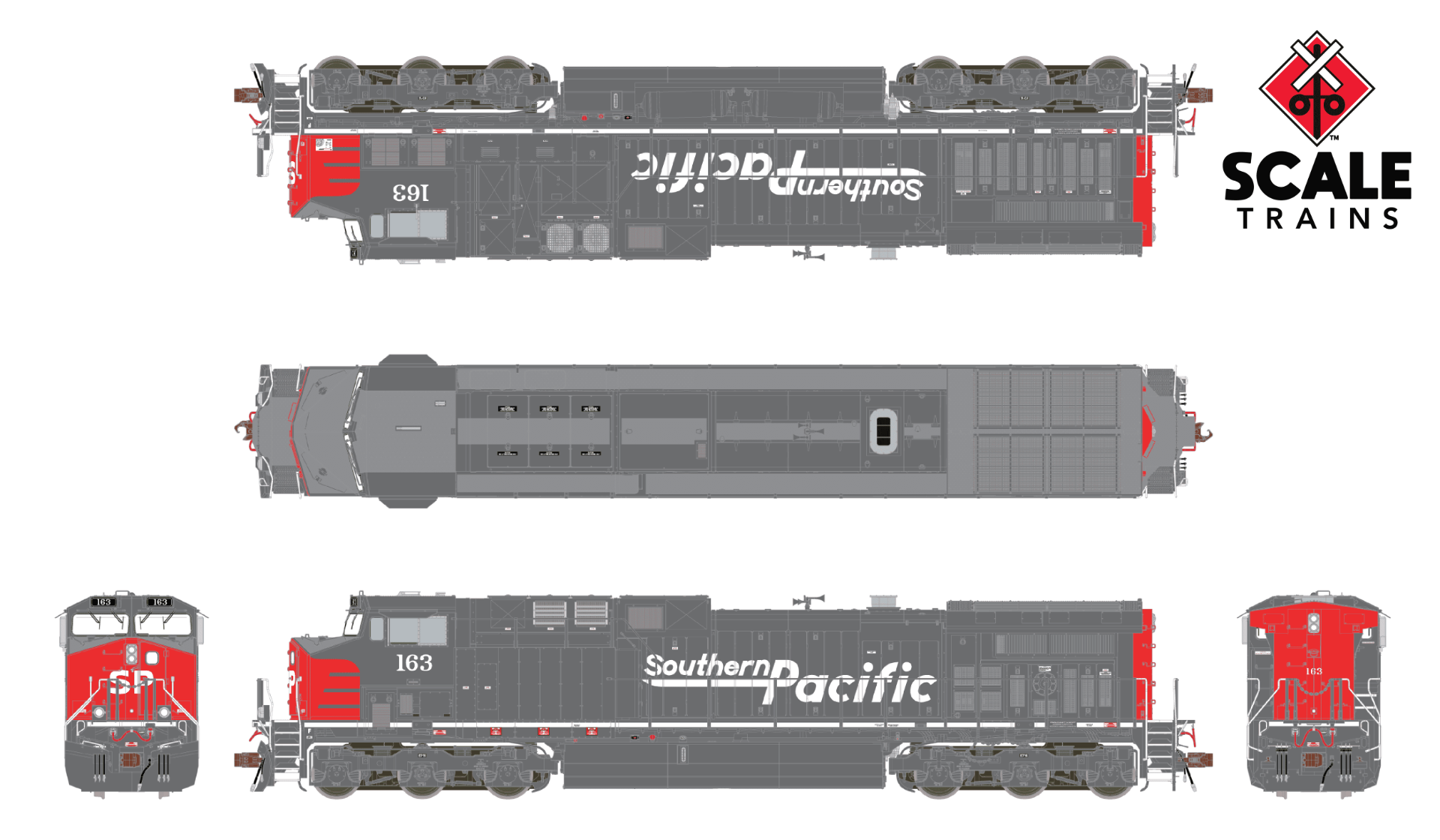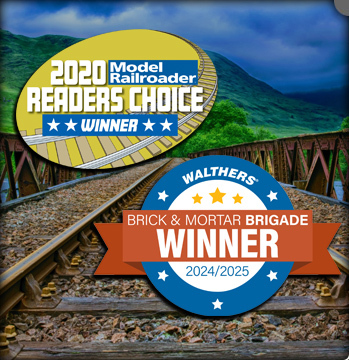ScaleTrains HO
ScaleTrains Rivet Counter HO SXT38482 DCC Ready GE AC4400CW Southern Pacific 'Speed Lettering' SP #163
- In Stock:
- 1
- Scale:
- HO
- SKU:
- SXT38482
Description
ScaleTrains Rivet Counter HO SXT38482 DCC Ready GE AC4400CW
Southern Pacific 'Speed Lettering' SP #163

Road Number Specific ScaleTrains
- All-new model/
- Era: 1995 to Late-90s
- SP 100-378, built 4-10/95
- Series 100 to 199; built 4-5/95
- Road numbers 100 and 142
- Left side auxiliary cab: three tall doors with latches on the #2
- No capacitor box on left side walkway
- Single large Sinclair 'ice skate' communication antenna, and small Sinclair 'ice skate' End of Train EOT telemetry antenna
- Late Hi-Ad trucks with cantilever struts on all four sideframes
- Road number 146
- SP sunset logo on inverter cabinet
- Left side auxiliary cab: three tall doors with latches on the #2
- No capacitor box on left side walkway
- Single large Sinclair 'ice skate' communication antenna, and small Sinclair 'ice skate' End of Train EOT telemetry antenna
- Late Hi-Ad trucks with cantilever struts on all four sideframe
- Road number 163
- Left side auxiliary cab: three tall doors with latches on the #2
- No capacitor box on left side walkway
- Single large Sinclair 'ice skate' communication antenna, and small Sinclair 'ice skate' End of Train EOT telemetry antenna
- Late Hi-Ad trucks with 'Cantilever' shock snubbers deleted from left front and right rear
- Series 200 to 300; built 5-7/95
- Road number 270
- No capacitor box on left side walkway
- Single large Sinclair 'ice skate' communication antenna, and three small Sinclair 'ice skate' End of Train EOT telemetry and Locotrol antennas
- Late Hi-Ad trucks with cantilever struts on right front and left rear sideframes
- Series 301 to 378; built 7-10/95
- Road number 350
- Left side auxiliary cab: three tall doors with latches on the #2
- Capacitor box on left side walkway
- Single large Sinclair 'ice skate' communication antenna, and three small Sinclair 'ice skate' End of Train EOT telemetry and Locotrol antennas
- Late Hi-Ad trucks with cantilever struts on right front and left rear sideframes
- Fully-assembled
- Multiple road numbers
- No truck ground lights, prototype not equipped
- Operating LED-illuminated front, rear, and side walkway lights*
- Operating LED-illuminated front deck-mounted alternating ditch lights**
- Printed high-mount cab number boards with separately controlled backlit LED-illumination*
- Tall snowplow with open doors and two grab irons
- Semi-scale coupler buffer equipped with durable metal semi-scale Type E knuckle couplers
- 5-step stepwells with see-through steps
- Walkway with front anticlimber
- GE 'nub' pattern walkway tread
- Narrow profile end handrails
- Dual dummy and single live pilot face MU connections
- Front nose headlight
- Nose door with window
- Two-piece nose top grab irons
- Battery cabinet access door without latch
- GE safety cab with three side windows
- Right side cab under floor access doors: four screened louver sections per door
- Left side cab under floor access doors: dual latch door with grille forward of the HVAC unit
- Cab interior with detailed back wall and front dash, high-back seats, conductor’s workstation, and engineer’s desktop controls
- Tinted cab side windows
- Tall mirror mounted in front of sliding cab side windows on both sides; additional small mirror on right side
- Early inverter cabinet: six tall vertical rectangular bolted panels and three horizontal short panels
- Alternating reinforcement ribs under dynamic brake intake grilles
- Standard dynamic brake exhaust 2-port
- Forward right-side air intake grille
- Right side auxiliary cab: four doors with latches on #1 and #4 doors
- Early curved engine cab profile
- Lost-wax brass cast Nathan AirChime P3 (P24R1 configuration) horn mounted on engine cab
- Early flanged exhaust stack housing
- 'Bathtub' exhaust silencer
- 26 individually-applied etched metal see-through radiator intake and exhaust grilles on sides and top of radiator compartment
- Late radiator door grilles in alternating heights
- Standard brake wheel
- Left rear hood door grille arrangement: tall, short, short grilles
- Tall, latched access door on long hood end
- Low-mounted rear sand fill
- Early 'box' lifting lugs on ends of radiator wings
- Accurately profiled frame with separately-applied plumbing and traction motor cabling
- Rotating axle bearing caps
- No speed recorder
- Dual Graham-White Prime 975-075 air filters
- Graham-White 975-100 'twin tower' air filter dryer
- 5,000-gallon fuel tank with vertical weld seams
- Single fuel fills per side
- Round and vertical analog fuel gauges; digital fuel gauges
- Fuel tank mounted steel bell
- Separate air tanks with upper mounting brackets
- Early square handbrake chain bracket
- SP-style spare coupler knuckle boxes on rear pilot face
- Factory-applied detail parts: wire grab irons, spare knuckles, trainline hoses with silver gladhands, 3-hose MU clusters with silver gladhands, uncoupling levers, windshield wipers, mirrors, sunshades, and more
- Motor with 5-pole, skew-wound armature
- Dual flywheels
- All-wheel drive
- All-wheel electrical pick-up
- Directional LED headlights
- Printing and lettering legible under magnification
- Operates on Code 70, 83, and 100 rail
- Packaging safely stores model
- Minimum Radius: 18”
- Recommended Radius: 22”
DCC & sound equipped locomotives also feature:
- ESU-LokSound 5 DCC and Sound decoder with 'Full Throttle' Functions
- Two cube-type speakers
- Accurate FDL-16 prime mover and auxiliary sounds, horn, bell, and more
- ESU-designed PowerPack with two super capacitors***
- Operates on both DC and DCC layouts****
DCC & sound ready locomotives also feature:
- Operate on DC layouts
- DCC ready with 21-pin connector
* Lighting features operate when using an ESU decoder with appropriate programming while operating using DCC
** In DC operation, both front ditch lights illuminate; rear ditch lights, if equipped, do not illuminate
*** Compatible with appropriately programmed ESU decoders while operating using DCC
****Lombard Hobbies Recommendation - As modelers ourselves we highly recommend ONLY running DCC on DCC systems and DC on DC systems, regardless of 'Dual-Mode' capability. This gives optimum performance and safeguards the unit from possible damage from running on a different system than originally intended and from any inexperienced operator errors.
PROTOTYPE HISTORY
The AC4400CW was based upon GE’s highly successful Dash 9-44CW design, and would become one of the hottest selling locomotives of the 1990s and beyond.
Initial AC4400CW customers utilized their units in applications best suited for their tremendous lugging ability. Based upon their satisfaction with the DASH 9 fleet and their desire for reliable power to move Powder River Basin coal, the Chicago & North Western was one of the first to purchase the newest A.C. power. Sets of AC4400s, painted in the attractive 'Lightning Stripe' variation of their classic green and yellow paint scheme, could be seen all over the Powder River Basin moving seemingly endless strings of coal hoppers or gondolas.
CSX Transportation was another early customer and ordered a sizable fleet of ACs for service in the Appalachian coal fields. Delivered in the attractive yellow, blue, and gray 'YN2' scheme, the new units quickly became crew favorites. The new AC4400CWs handily outperformed older locomotive models in their daunting assignment.
Western giant Southern Pacific stunned the industry with a massive order of 278 units. All were delivered in their longtime gray and scarlet, but with the Rio Grande Industries inspired 'Speed Lettering' on their flanks. While SP struggled financially throughout the 1980s, by the 1990s they were seemingly on the rebound, ordering large numbers of high-horsepower, 4-axle units over the previous years, for use on high-speed, high-priority intermodal traffic. However, SP’s 6-axle heavy-haul fleet had languished over the years, and the ACs were a much-needed shot in the arm. A.C. power allowed SP to handle growing amounts of bulk traffic, coal, minerals, crude oil, and grain, across the system.
Enticed by the promises of improved train handling and reduced maintenance costs, more and more railroads took notice and joined the A.C. revolution. Eventually, as operating practices evolved, ACs would find themselves in services beyond the heavy-tonnage applications they were originally envisioned for. As piggyback traffic dwindled and heavier double-stack container trains became more prevalent, AC4400s started finding their way onto those trains, where again their performance characteristics proved their value. As older power was retired or cascaded down into more secondary duties, ACs were finding themselves on just about every service on the railroad.
By the time domestic AC4400 production ended in 2004, nearly every Class 1 railroad had ordered examples of AC4400s except for Norfolk Southern. Ever the holdout, NS avoided safety cabs and AC-traction as long as possible. Instead, they would purchase standard-cab DASH 9s as well as large numbers of its safety-cab equipped version, the C40-9W. Into the 2000s however, NS would eventually acquire AC-traction locomotives, and were impressed with their performance. So much so, they would embark on a rebuilding and upgrading program for their older DASH 9 locomotives, dubbing them 'AC44C6M', AC traction, 4,400hp, C for six axles, the number 6 to signify the number of traction motors, and M for 'Modified.. They would have their cabs replaced with the latest GE safety cab design, plus new electrical systems, and components upgraded to AC4400 standards.
In recent years, railroads such as Canadian Pacific, CSX, and Union Pacific have embarked on rebuilding programs for their AC4400 fleets. These programs replace worn out or obsolete components, plus upgrading various systems to improve performance. While examples of the competing EMD product have not been as fortunate. In fact, some have already been retired and scrapped. Aside from wreck victims, nearly all AC4400s are still in service. With rebuild and upgrade programs, they will likely be in service for many years to come.
Lombard Hobbies - Your #1 Largest Authorized ScaleTrains Select Retailer!































